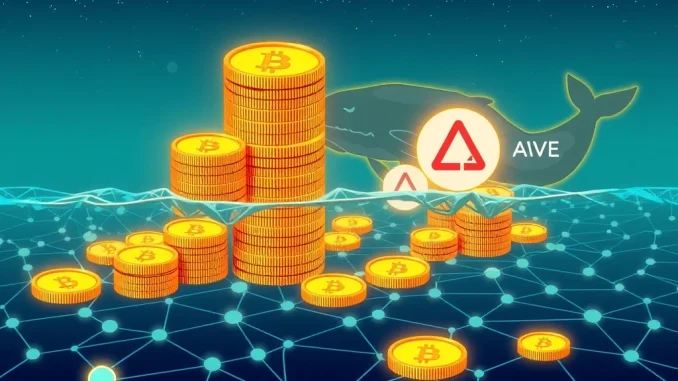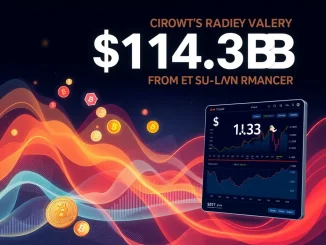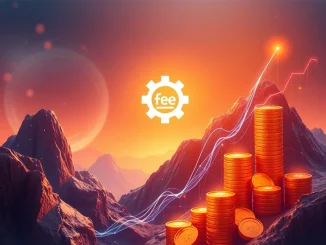
Big news from the crypto world! A massive USDT transfer, valued at an eye-watering $600 million, recently caught the attention of market watchers. According to blockchain tracking service Whale Alert, this significant sum moved from the cryptocurrency exchange HTX to the decentralized finance (DeFi) protocol Aave. This isn’t just any transaction; it’s a prime example of a large crypto transfer executed by a potential crypto whale, and it immediately raises questions about the motivations behind such a substantial movement.
The Anatomy of the $600M USDT Transfer
Let’s break down the specifics of this notable transaction:
- Asset: 600,000,000 USDT
- Value: Approximately $600,000,000 USD
- Origin: HTX (formerly Huobi) exchange wallet
- Destination: Aave protocol address
- Reported by: Whale Alert
USDT, or Tether, is the largest stablecoin by market capitalization, pegged roughly 1:1 with the US dollar. Its stability makes it a crucial asset for liquidity and value transfer within the crypto ecosystem. Moving such a vast amount of USDT indicates a strategic decision by a holder with significant capital.
From HTX to Aave: Centralized vs. Decentralized
The movement of funds from HTX, a major centralized cryptocurrency exchange, to Aave, a leading decentralized lending and borrowing protocol, highlights a shift from a CEX environment to a DeFi one. Why would a large holder make this transition?
Centralized exchanges like HTX are platforms where users trade assets, often store funds, and rely on the exchange’s infrastructure for security and operations. DeFi protocols like Aave, conversely, operate on blockchain networks (primarily Ethereum, Polygon, Avalanche, etc.) using smart contracts to facilitate financial services like lending, borrowing, and staking without intermediaries.
Moving $600 million in USDT from HTX means withdrawing it from the exchange’s custody and depositing it into a smart contract on a DeFi protocol like Aave. This action typically signifies an intent to engage with the services offered by the DeFi platform rather than just holding or trading on the exchange.
The Crypto Whale Factor: Unpacking Potential Motivations
A transaction of this size is characteristic of a crypto whale – an individual or entity holding a large amount of cryptocurrency. Whale movements are closely watched because they can sometimes signal market sentiment or strategic positioning. What might compel a whale to move $600 million in USDT to Aave?
Several possibilities exist:
- Seeking Yield: Aave allows users to earn interest by depositing assets like USDT. A $600 million deposit, even at modest stablecoin APYs, can generate significant returns over time.
- Borrowing Against Collateral: The whale might intend to use the deposited USDT as collateral to borrow other cryptocurrencies (like ETH, BTC, or other stablecoins) on Aave. This is a common strategy for leveraging positions or gaining access to other assets without selling the deposited USDT.
- Participating in DeFi Strategies: The funds could be earmarked for more complex DeFi strategies, such as yield farming loops, liquidity provision in other protocols, or participating in Aave’s governance.
- Diversification/Risk Management: While HTX is a large exchange, some whales might choose to move a portion of their assets into decentralized protocols to spread risk or gain direct control over their funds via self-custody (after withdrawal from the exchange).
- Market Sentiment Play: A large deposit into a leading DeFi protocol could signal confidence in the DeFi ecosystem’s health and potential for future growth or yield generation compared to opportunities on centralized platforms.
Pinpointing the exact reason for this specific large crypto transfer is difficult without direct information from the wallet owner, but the move strongly suggests an active engagement with the DeFi landscape via Aave.
Impact on Aave and the DeFi Lending Landscape
A $600 million deposit is substantial even for a protocol as large as Aave. This influx of USDT significantly increases the available liquidity within Aave’s USDT pool. This can have several effects on the DeFi lending environment:
- Increased Lending Capacity: More USDT available means more users can potentially borrow USDT from Aave.
- Potential Impact on Interest Rates: While complex algorithms govern Aave’s interest rates, a massive deposit *can* potentially slightly decrease the lending APY for USDT depositors (due to higher supply) and potentially slightly decrease the borrowing APY for USDT borrowers (due to higher availability), depending on demand and other factors.
- Boost to Aave’s Total Value Locked (TVL): This single transaction adds $600 million to Aave’s TVL, reinforcing its position as a leading DeFi protocol.
This kind of movement underscores the critical role stablecoins like USDT play in fueling the DeFi lending ecosystem, providing the necessary capital for borrowing and yield generation activities.
Why Monitor Large Crypto Transfer Events?
Tracking large crypto transfer events, especially those involving exchanges and major protocols, offers valuable insights:
- Market Sentiment: Large movements can sometimes precede significant market events or indicate whale confidence (or lack thereof) in certain platforms or strategies.
- Liquidity Shifts: Transfers show where significant capital is flowing, affecting liquidity on exchanges or within DeFi protocols.
- Potential Strategy Signals: The destination of funds (e.g., exchange, DeFi protocol, cold storage) can hint at the whale’s intentions (trading, yield, long-term holding).
Conclusion: A Significant USDT Transfer with Ripple Effects
The USDT transfer of $600 million from HTX to Aave is a noteworthy event in the crypto space. It represents a substantial large crypto transfer by a likely crypto whale, signaling a move from a centralized exchange environment into the decentralized world of DeFi lending. While the precise motivation remains speculative, the deposit significantly boosts Aave’s liquidity and highlights the ongoing strategic maneuvers by large capital holders within the crypto ecosystem. Monitoring such large movements provides a fascinating glimpse into the strategies shaping the decentralized finance landscape and the flow of stablecoin capital.



